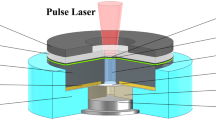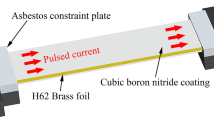Abstract
Laser shock hydraulic microforming (LSHM) is a new microforming that combines the advantages of laser shock microforming and impact hydroforming. LSHM uses monopulse laser to drive the rubber layer for squeezing liquid medium to form metal foils. The size effect and forming mechanism under this process will surely introduce new features, and they were explored in terms of maximum bulge height, surface topography, thickness distribution, microhardness, microstructure, and elastic recovery. When N=t/d (thickness/grain size)>1, the N value decreases, the maximum bulge height and thickness thinning increase, and the roughening of surface topography is not obvious. When N<1, the maximum bulge height decreases, the topography becomes coarser significantly, and the thinning regularity decreases. The LSHM process can greatly improve the thinning at fillet area due to the pressure equalization effect of liquid and the replenishment of material flow. The maximum thinning occurs at the bottom transition area. The area with the highest hardness is the bottom because of the coupling effect of high strain rate and plastic deformation on the increase in dislocation density. When N<4.3, this case conforms to conventional Hall−Petch tendency because dislocation movement is the dominant deformation. When N>4.3, this case accords with inverse Hall−Petch tendency because twin nucleation is dominant. When N<1, the deep elastic recovery rate is much greater than that when N>1 due to the increase in the scale of grain atoms. The increase in laser power density can appropriately reduce the elastic recovery ratio because of grain refinement.






















Similar content being viewed by others
Availability of data and materials
Not applicable.
References
Engel U, Eckstein R (2012) Microforming—from basic research to its realization. J Mater Process Technol 125:35–44. https://doi.org/10.1016/S0924-0136(02)00415-6
Ma ZW, Tong GQ, Chen F (2017) Tensile properties and fractographs of Ti-2.5Al-1.5Mn foils at different temperatures. Rare Metals 36:247–255. https://doi.org/10.1007/s12598-016-0835-z
Deng JH, Fu MW, Chan WL (2011) Size effect on material surface deformation behavior in micro-forming process. Mater Sci Eng A 528:4799–4806. https://doi.org/10.1016/j.msea.2011.03.005
Vollertsen F, Hu Z, Niehoff HS, Theiler C (2004) State of the art in micro forming and investigations into micro deep drawing. J Mater Process Technol 151:70–79. https://doi.org/10.1016/j.jmatprotec.2004.04.266
Geiger M, Kleiner M, Eckstein R, Tiesler N, Engel U (2001) Microforming. CIRP Ann 50:445–462. https://doi.org/10.1016/S0007-8506(07)62991-6
Raulea LV, Goijaerts AM, Govaert LE, Baaijens FPT (2001) Size effects in the processing of thin metal sheets. J Mater Process Technol 115:44–48. https://doi.org/10.1016/S0924-0136(01)00770-1
Gao ZY, Peng LF, Yi PY, Lai XM (2015) Grain and geometry size effects on plastic deformation in roll-to-plate micro/meso-imprinting process. J Mater Process Technol 219:28–41. https://doi.org/10.1016/j.jmatprotec.2014.12.005
Chan WL, Fu MW, Yang B (2012) Experimental studies of the size effect affected microscale plastic deformation in micro upsetting process. Mater Sci Eng A 534:374–383. https://doi.org/10.1016/j.msea.2011.11.083
Wang JL, Fu MW, Ran JQ (2014) Analysis of the size effect on springback behavior in micro-scaled U-bending process of sheet metals. Adv Eng Mater 16:421–432. https://doi.org/10.1002/adem.201300275
Chen CC (2016) Experimental study on formability of phosphor bronze thin sheet in micro bead forming process. Int J Adv Manuf Technol 84(9-12):1897–1905. https://doi.org/10.1007/s00170-015-7860-1
Xu ZT, Peng LF, Yi PY, Lai XM (2018) An investigation on the formability of sheet metals in the micro/meso scale hydroforming process. Int J Mech Sci 150:265–276. [11]. https://doi.org/10.1016/j.ijmecsci.2018.10.033
Gau JT, Principe C, Wang JW (2007) An experimental study on size effects on flow stress and formability of aluminum and brass for microforming. J Mater Process Technol 184:42–46. https://doi.org/10.1016/j.jmatprotec.2006.11.003
Zheng C, Zhang X, Liu Z, Ji Z, Yu X, Lb S (2018) Investigation on initial grain size and laser power density effects in laser shock bulging of copper foil. Int J Adv Manuf Technol 96:1483–1496. https://doi.org/10.1007/s00170-018-1722-6
Wang X, Ma YJ, Shen ZB, Gu YX, Zhang D, Qiu TB, Liu HX (2015) Size effects on formability in microscale laser dynamic forming of copper foil. J Mater Process Technol 220:173–183. https://doi.org/10.1016/j.jmatprotec.2015.01.020
Liu HX, Sun XQ, Shen ZB, Li LY, Sha CF, Ma YJ, Gau JT, Wang X (2017) Experimental and numerical simulation investigation on laser flexible shock micro-bulging. Metals 7:93–108. https://doi.org/10.3390/met7030093
Zheng C, Zhang X, Zhan YL, Ji Z, Luan YG, Song LB (2017) Effects of laser power density and initial grain size in laser shock punching of pure copper foil. Opt Lasers Eng 105:35–42. https://doi.org/10.1016/j.optlaseng.2017.12.009
Liu HX, Gong JX, Ma YJ, Cui JK, Li MW, Wang X (2020) Investigation of novel laser shock hydroforming method on micro tube bulging. Opt Lasers Eng 129:106073. https://doi.org/10.1016/j.optlaseng.2020.106073
Wang X, Du DZ, Zhang H, Shen ZB, Liu HX, Zhou JZ, Liu H, Hu Y, Gu CX (2013) Investigation of microscale laser dynamic flexible forming process-simulation and experiments. Int J Mach Tool Manu 67:8–17. https://doi.org/10.1016/j.ijmachtools.2012.12.003
Zheng C, Sun S, Ji Z, Wang W (2010) Effect of laser energy on the deformation behavior in microscale laser bulge forming. Appl Surf Sci 257:1589–1595. https://doi.org/10.1016/j.apsusc.2010.08.099
Zhang WW, Yao YL, Noyan IC (2004) Microscale laser shock peening of thin films,part1: Experiment, modeling and simulation. J Manuf Sci E-T ASME 126:10–17. https://doi.org/10.1115/1.1645878
Zheng C, Ji Z, Song LB, Fu J, Zhu YH, Zhang JH (2015) Variation of fracture mode in micro-scale laser shock punching. Opt Laser Technol 72:25–32. https://doi.org/10.1016/j.optlastec.2015.03.009
Fu MW, Yang B, Chan WL (2013) Experimental and simulation studies of micro blanking and deep drawing compound process using copper sheet. J Mater Process Technol 213:101–110. https://doi.org/10.1016/j.jmatprotec.2012.08.007
Peng LF, Lai XM, Lee HJ, Song JH, Ni J (2009) Analysis of micro/mesoscale sheet forming process with uniform size dependent material constitutive model. Mater Sci Eng A 526:93–99. https://doi.org/10.1016/j.msea.2009.06.061
Liu JG, Fu MW, Chan WL (2012) A constitutive model for modeling of the deformation behavior in microforming with a consideration of grain boundary strengthening. Comput Mater Sci 55:85–94. https://doi.org/10.1016/j.commatsci.2011.11.018
Liu HX, Jiang CK, Liu F, Ma YJ, Wang X (2019) Numerical and experimental investigations of laser shock hydraulic microforming for thin-walled foils. Thin-Walled Struct 143:106219. https://doi.org/10.1016/j.tws.2019.106219
Peng LF, Xu ZT, Gao ZY, Fu MW (2018) A constitutive model for metal plastic deformation at micro/meso scale with consideration of grain orientation and its evolution. Int J Mech Sci 138:74–85. https://doi.org/10.1016/j.ijmecsci.2017.11.046
Li JH, Li FG, Zhao C, Chen H, Ma XK, Li J (2016) Experimental study on pure copper subjected to different severe plastic deformation modes. Mater Sci Eng A 656:142–150. https://doi.org/10.1016/j.msea.2016.01.018
Rohith P, Sainath G, Srinivasan VS (2019) Effect of size, temperature and strain rate on dislocation density and deformation mechanisms in Cu nanowires. Physica B 561:136–140. https://doi.org/10.1016/j.physb.2019.03.003
Hall EO (1954) Variation of hardness of metals with grain size. Nature 173:948–949. https://doi.org/10.1038/173948b0
Li JJ, Lu BB, Zhang YH, Zhou HJ, Hu GM, Xia ren (2020) Nanoindentation response of nanocrystalline copper via molecular dynamics: grain-size effect. Mater Chem Phys 241:122391. https://doi.org/10.1016/j.matchemphys.2019.122391
Voisin T, Grapes MD, Li TT, Santala MK, Zhang Y, Ligda JP, Lorenzo NJ, Schuster BE, Gampbell GH, Weihs TP (2020) In situ TEM observations of high-strain-rate deformation and fracture in pure copper. Mater Today 33:10–16. https://doi.org/10.1016/j.mattod.2019.11.001
Kuhlmann-Wilsdorf D (1989) Theory of plastic deformation:-properties of low energy dislocation structures. Mater Sci Eng A 113:1–41. https://doi.org/10.1016/0921-5093(89)90290-6
Tao NR, Wang ZB, Tong WP, Sui ML, Lu J, Lu K (2002) An investigation of surface nanocrystallization mechanism in Fe induced by surface mechanical attrition treatment. Acta Mater 50:4603–4616. https://doi.org/10.1016/S1359-6454(02)00310-5
Funding
This work is supported by the National Science Foundation of China (Grant No.52075226) and the Innovation Practice Fund of Jiangsu University Industrial Centre (Grant No.ZXJG2019094).
Author information
Authors and Affiliations
Contributions
Xin Gu wrote the first draft of the paper. All authors revised and approved the final version of the manuscript.
Corresponding author
Ethics declarations
Ethics approval
Not applicable.
Consent to participate
Not applicable.
Consent for publication
Not applicable.
Competing interests
The authors declare no competing interests.
Additional information
Publisher’s note
Springer Nature remains neutral with regard to jurisdictional claims in published maps and institutional affiliations.
Rights and permissions
About this article
Cite this article
Gu, X., Wang, X., Ma, Y. et al. Investigation on grain size effect and forming mechanism of laser shock hydraulic microforming of copper foil. Int J Adv Manuf Technol 114, 1049–1064 (2021). https://doi.org/10.1007/s00170-021-06969-9
Received:
Accepted:
Published:
Issue Date:
DOI: https://doi.org/10.1007/s00170-021-06969-9




